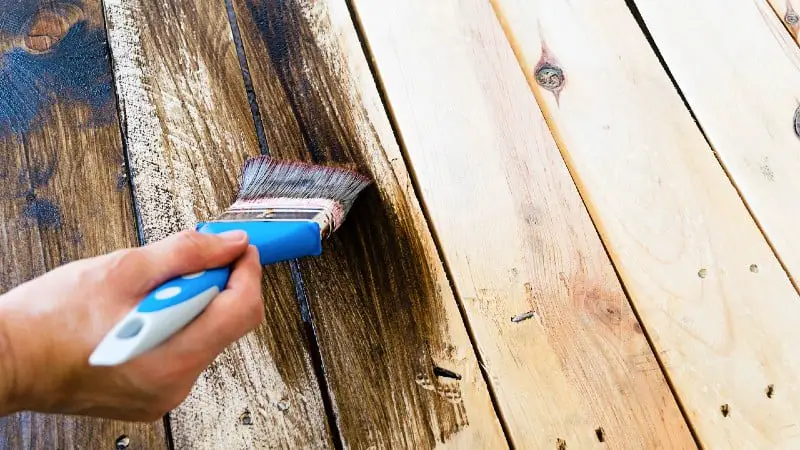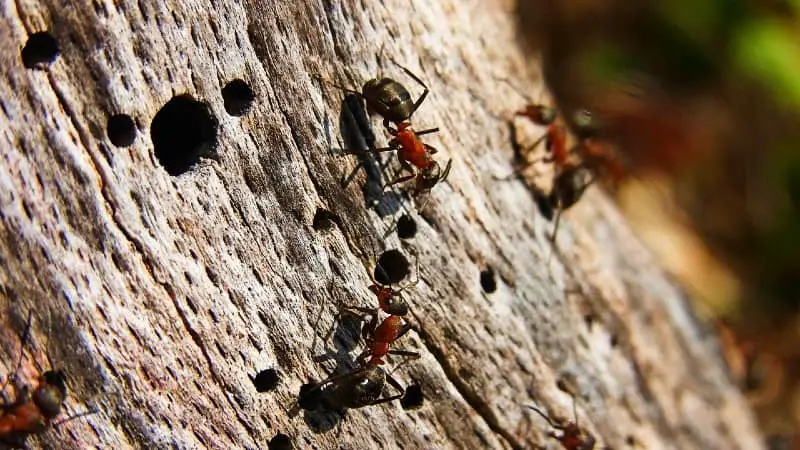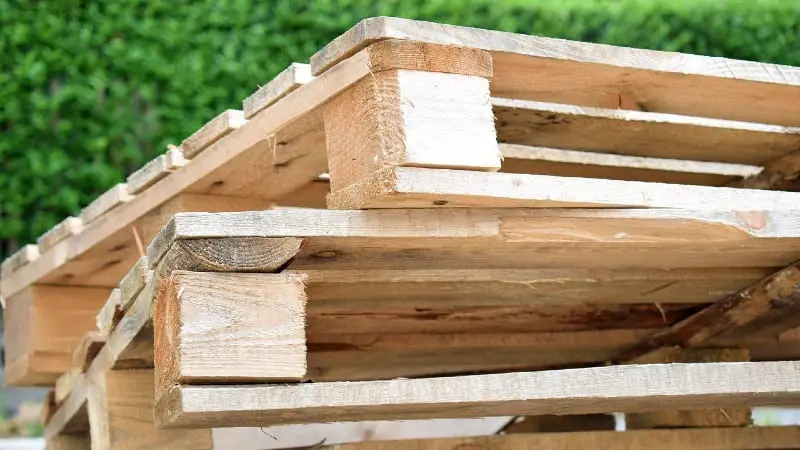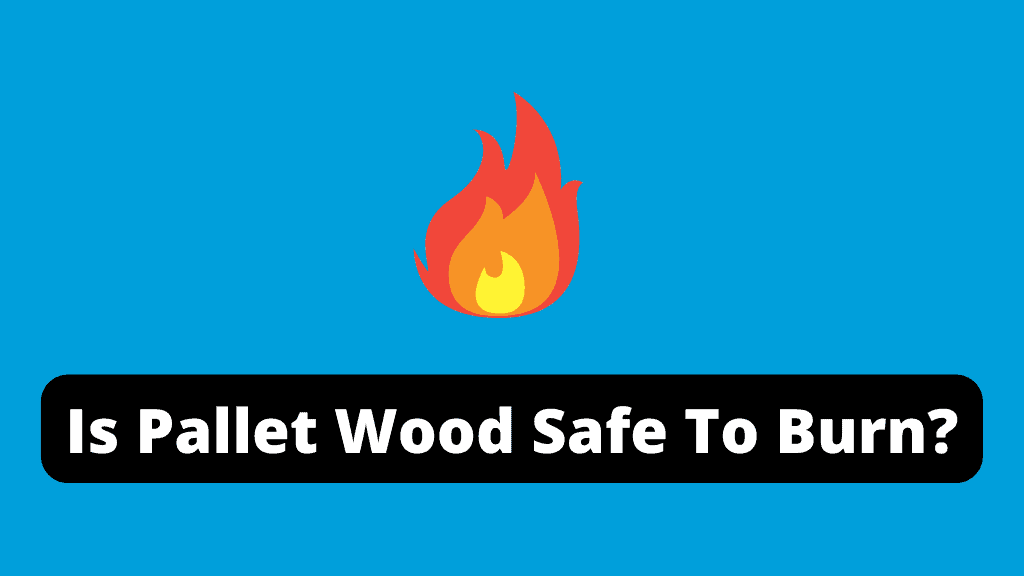Is pallet wood safe to burn? If you’re a DIYer or new to woodworking, this is a question that has likely crossed your mind. It’s a reasonable concern, because most of the pallets you find are free and good for making everything from furniture to garden beds. They often come in sizes that are very useful for any number of projects. But is it really okay to burn them?
The short answer: Yes. When looking for a pallet, you need to make sure that it has not been treated with chemicals. Knowing the history of a pallet can be helpful, too. For example: mold might grow on pallets that got wet at some point in the past. In general, safe pallets come from local businesses, hardware stores, furniture stores, and appliance stores—places like that.
The sections below answer this question in more detail:
Wood pallets can contain toxic chemicals
Did you know that pallets used to transport toxic chemicals can become contaminated themselves? If your pallets have been exposed to any sort of chemical, it’s best not to burn them—you don’t want to breathe in toxic fumes or harm the environment.
In fact, burning wood treated with chemicals is illegal in many states. I wrote another article about burning wood. Burning it can release toxins into the air, harming humans and animals alike.
Some pallet wood has been treated with wood stain
You might be tempted to think that pallets are made of cheap, easily-recycled wood that you can burn in your fireplace or wood stove. But you’d be wrong! Some pallets have been treated with wood stain that’s illegal to burn, and can release dangerous chemicals into the air when you do.
In other words, you can’t just throw it into your fireplace or wood stove and call it a day. If you do, you might end up breathing in toxic fumes—or worse, setting off a chemical reaction that harms the environment.
It’s important to know the potential dangers of burning pallet wood treated with wood stain. Toxins can be released into the air and cause health problems for humans and animals alike. We must take care to use products responsibly in order to protect our environment and ourselves.

Some pallet wood has been painted
Has it been painted? If so, don’t burn it! The paint can release toxic chemicals into the air while they’re being burned—and that’s bad news for anyone who breathes near them.
These toxins are known to cause a variety of health problems. Burning painted pallet wood is not only bad for your health, but also harms the environment.
Also, painted pallet wood is really chemically treated wood. Open-air burning of any treated wood is prohibited in many states. It is possible to dispose of chemically treated wood in an appropriate landfill. I wrote another article about burning painted wood.
Some pallets have been treated with pesticides
Not all pallets have been treated with pesticides—but some have. It’s important to know the difference between the two because burning treated pallets can release harmful chemicals into your living space.
Burning pallets that have been treated with pesticides releases harmful chemicals into the air, putting your family at risk.
The best way to avoid this problem is to find out if the pallets have been treated with pesticides before burning them.
Burning treated pallets is not only dangerous but illegal in some states.

Pallet wood may have mold
First, some pallet wood can become infected with mold. Pallets made of heat-treated wood are less likely to have mold, but if they get wet at some point (like during transport), the likelihood of mold increases.
It’s not a good idea to burn moldy pallet wood because the spores can spread through the air and cause health problems. Also, if you burn this wood indoors, mold spores can travel within your house.
Mold is everywhere—in our homes, on our foods, and even in the air around us. Mold grows when spores from fungi find a suitable environment. It can eat away at your favorite shoes and leave them covered in tiny black spots or make your bread taste weird. But not all molds are bad; some are actually beneficial to humans! I wrote another article about cleaning pallet wood.
Pallet wood may be infested with parasites
So you’ve just discovered that your new pallet is infested with parasites. Maybe it’s termites, or ants, or bees—but whatever it is, you don’t want them in your house and you definitely don’t want to bring them inside.
You might be wondering: Can I still burn this pallet?
Well, the answer is yes—but only if you’re burning the wood outdoors, away from your home. Burning pallet wood indoors can increase the risk of bringing parasites into your house and causing damage to your property.
If you’re using a stove in your home (and who doesn’t?), keep an eye out for signs of infestation before bringing any potentially infected wood inside to burn.

How can I select pallet wood that is safe to burn?
The best way to do this is by inspecting the pallet. Look for any signs of damage or discoloration. If you see any, move on to a different pallet.
You can also check for an IPPC stamp on the pallet. To describe what I mean, I need to go into a little more detail:
The IPPC is the International Plant Protection Convention, a treaty signed by many countries throughout the world. It was formed to help control the introduction and spread of pests in order to protect native plants.
In order to do this, they established IPSM 15 (International Standards for Phytosanitary Measures Number 15). This measure described several approved treatments for wood.
In this article, we are talking about wooden pallets used in the transport of goods from one country to another. IPSM 15 requires that pallets used for such transport have stamps on them. The information in the stamp would include the country of origin for the pallet and also the type of treatment that the pallet received. Some of the possible treatments are listed below:
DB
This stands for Debarked and it means that the bark of the tree has been removed. This treatment provides some level of protection again insect infestation.
HT
This stands for heat-treated and refers to heating wood to a minimum temperature of 56 degrees centigrade for at least 30 minutes. This kills most (but not all) insects infesting wood.
If the stamp says HT (for Heat-treated), the pallet MAY be OK to burn. However, the wood may still be infected with mold, even if heat-treated:
…pallets can be rewetted when stored outdoors, allowing other mold fungi to colonize the wood…even kiln-dried wood can experience mold attack when it is rewetted…Many producers also have a misconception that heat treatment will provide protection against mold attack…
Jeff Morrell, PH.D., National Wooden Pallet & Container Association
MB
This wood has been fumigated with the pesticide Methyl Bromide. This chemical is an extremely toxic substance and can be hazardous to humans. For example:
- It can cause cancer
- it can harm the kidneys
- it can damage the nervous system
- It can irritate the lungs
Do not burn pallet wood with stamps that say MB!
Finding safe pallet wood
Pallet wood is a great resource for DIYers and those new to woodworking, but it can be hard to know whether or not the pallets you’re using are safe. There are a few sources for pallets that are usually safe:
Local businesses – They often have extra materials that they’re willing to give away for free. They may not always be in good condition, but they’re usually safe to burn.
Appliance stores – They are often a great source of pallet wood! Just make sure the pallets don’t contain any toxic chemicals before burning them.
Furniture stores – They will usually offer old furniture that’s been returned or discontinued—another great source of pallet wood! As with appliance stores, make sure there aren’t any toxic chemicals in the wood before burning it.
Hardware stores – They sometimes have leftover materials from building projects or other jobs—another great source of pallet wood! Just like with other sources of pallet wood, make sure there aren’t any toxic chemicals in the wood before burning it.

Conclusion
You may have concluded that pallets are not a great source of wood for burning. Pallets can contain harmful chemicals and heavy metals, which can be released when they are burned. However, there are ways to identify if the pallet is safe to burn or not. If it has an IPPC stamp and it says MB, the pallet should NOT be burned. If it says HT and has no chemical stains or mold, it might be OK to burn.
However, what if it has no IPPC stamp? In this case, the pallet was probably created for transport within this country. It might be safe to burn.
Some of the best sources for safe pallets include:
- local businesses
- Appliance stores
- Furniture stores
- Hardware stores
Did you enjoy reading this article? If so, you might want to visit my Pinterest profile. It contains pins about Woodworking, DIY & Crafts, Tools, Projects, Hardware, and other related topics!

